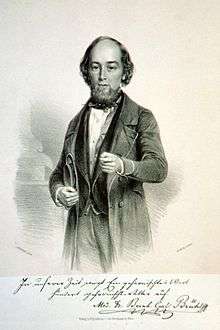Carl Brühl
Carl-Bernhard Brühl (5 May 1820, Prague – 14 August 1899, Graz) was an Austrian physician and anatomist known for his work in the field of comparative osteology.

He studied medicine in Vienna, later spending several years as a practicing physician. In 1857 he was appointed professor of zootomy and comparative anatomy in Krakow. In 1861 he became a professor of zootomy in Vienna, where in 1863, he was named director of the zootomic institute.[1]
In Vienna, he conducted popular scientific lectures free of charge, a practice that was almost unheard of at the time. His lectures were also available to female listeners, causing a stir of serious controversy in academic circles.[2] Sigmund Freud, in his 1925 autobiographical study, mentioned that it was hearing Brühl's reading of Goethe's "Die Natur" that persuaded him to enter medical school.[3]
Selected works
- Die Methode des osteologischen Details : dargestellt am Karpfen-skelette, 1845 - Method of osteological details; presentations of carp skeletons.
- Anfangsgründe der vergleichenden Anatomie aller Thierklassen, zum Selbststudium, 1847 - Basics of comparative anatomy in regards to all classes of animals.
- Zur Kenntniss des Orang-Kopfes und der Orangarten, 1856 - In regards to the knowledge of the orangutan head and the orangutan species.
- Das Skelet der Krokodilinen : dargestellt in zwanzig Tafeln zur Erleichterung des Selbststudiums, sammtlich nach der Natur gezeichnet, in Zink gestochen und erläutert, 1862 - The skeleton of crocodilians, etc.
- Zootomie aller Thierklassen für Lernende, nach Autopsien, skizzirt, 1874 - Zootomy of all animal classes, according to autopsies.
- Zur osteologie der knochenfische. Nach materialien aus dem pariser pflanzengarten, 1887 - Osteology of boned fish.[4]
References
- Biography in German @ Österreichisches Biographisches Lexikon 1815–1950.
- Statements based on translated text from an equivalent article at the German Wikipedia.
- Analytical Psychology and German Classical Aesthetics: Goethe, Schiller, et al by Paul Bishop
- WorldCat Identities Most widely held works by Carl Bernhard Brühl